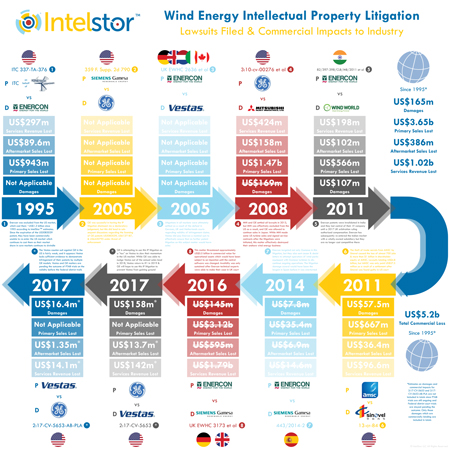 Since 1995 the wind energy industry has suffered more than US$ 5.2 billion in commercial losses associated with intellectual property risks which went unmitigated and could have been avoided.
Since 1995 the wind energy industry has suffered more than US$ 5.2 billion in commercial losses associated with intellectual property risks which went unmitigated and could have been avoided.By Philip Totaro, Founder and CEO, IntelStor, USA
These losses have come in the form of legal damages to the tune of US$ 165 million, but the bigger chunk is directly related to the other commercial impacts associated with an intellectual property (IP) dispute. These include blocking of product sales, denial of market access, and the loss of revenue from aftermarket part sales for the non-existent product sales as well as the accompanying service contracts which are becoming increasingly lucrative as assets age.
Companies certainly have a right to enforce their IP rights, but when those IP rights are used to exclude competition from markets, it eliminates choice for project developers when it comes to supply contracts. This weaponisation of IP rights has cost companies more than US$ 3.65 billion in product sales, US$ 386 million in aftermarket part sales and US$ 1.02 billion in services revenue.
The industry is still at risk, with potentially billions in patent infringement liability still not formally mitigated during project finance due diligence. For instance, the industry would have faced a total of more than US$ 11 billion if Enercon had been more successful with its enforcement licensing activities against Vestas and Siemens Gamesa.
Beyond those avoided costs, every single wind energy project which goes through a project finance due diligence almost never takes into account the commercial impacts on the project developers and asset owners, which are contractually left very murky and favourable to the supply companies resulting from clauses related to IP risk. This is to the detriment of the developer, financier and insurance carrier should a dispute between two equipment suppliers erupt.
Although the frequency of this occurring may be considered ‘rare’ versus other risks which are routinely underwritten, the price tag for being on the wrong side of an IP infringement can be substantial.
Famously, Enercon not only sued Gamesa for patent infringement liability in Spain on a wind turbine control patent, but it also sent demand letters to the asset owners of the Gamesa products it believed to infringe its patent. Those asset owners were contractually liable for some of the damages, because they did not have full indemnity for patent infringement liability in the turbine supply contract.
Recommendations to safeguard developers/owners from IP infringement risks include a mandatory full indemnity for patent infringement liability either during the request for proposal (RFP) or the turbine supply agreement (TSA) negotiations. Just like the requirement for a turbine supplier to carry property and casualty insurance, making patent infringement indemnity insurance coverage mandatory can also be specified in the RFP or TSA negotiations.
Whether full indemnity is provided or whether insurance is obtained, an independent validation of patent infringement risk position is possible. This data can be provided to developers/owners as well as the insurance providers during the TSA negotiation.
The consequences of this could be far-reaching because even if an injunction and a stop on production is not implemented as a result of the trial, owners could still see lost production due to a swap out of wind turbine controls or hardware which is found to infringe patents. Additional financial liabilities can pile up for every day on which an infringement turbine is operated until/unless the software or hardware swap out is made.
In many cases the risk mitigation protocol used by most turbine suppliers is likely inadequate. Prior to a product launch into a new market, some proactive turbine suppliers conduct a freedom to operate review in order to ensure they and their prospective customers will have no risk of patent infringement liability.
As a result, most turbine suppliers feel justified in their non-infringement position already and feel no additional work is required. Unfortunately, some turbine suppliers either are resource constrained or simply do not take the time to engage in this type of risk mitigation.
There is an opportunity for proactive companies to undergo an independent IP review and risk mitigation as part of the project finance due diligence. Those companies that have proactively undertaken an independent IP review have saved more than US$ 300 million in royalty costs avoided since 2010.
The implications of patent infringement can be substantial but this risk can indeed be quantified and mitigated. Companies must be more proactive to deal with IP risk during project finance due diligence.








